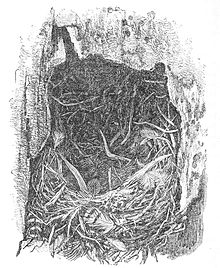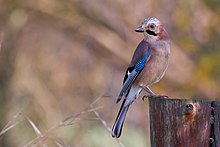Corsican nuthatch
It is threatened by loss of nesting sites and habitat fragmentation, with an estimated population size of about 2,000 individuals, possibly in moderate decline.The Corsican nuthatch was discovered when ornithologist John Whitehead went to observe alpine swifts (Tachymarptis melba) on 13 June 1883.[3] The Italian ornithologist Enrico Hillyer Giglioli reported in 1890 that he had observed the bird on 16 September 1877 at Ponte Leccia, almost six years before Whitehead, but mistaking it for a Eurasian nuthatch (S. europaea), he did not bother to shoot it.[5] In the spring of 1896, the German naturalist Alexander Koenig visited the forest of Vizzavona and collected with great difficulty five specimens; in the early autumn of 1900, Arnold Duer Sapsworth brought back some skins.The next collections were made between 1908 and 1909 by the British ornithologist Francis Charles Robert Jourdain, who provided some additional field notes and explained the difficulty of accessing the nests.[4] The first works concerning the biology of the bird were only carried out in the 1960s by the German ornithologist Hans Löhrl, who studied the reproduction, feeding and behaviour of the species.Since the 1990s, the species has been studied closely by local groups, and in particular by ornithologists Jean-Claude Thibault, Pascal Villard and Jean-François Seguin.[7]: 4 In the summer of 2006, a Dutch group participating in an entomological expedition incidentally observed a pair of nuthatches in the Altai, near the meeting point of China, Kazakhstan, Mongolia and Russia, in a pure Siberian larch (Larix sibirica) forest.[4][7]: 6–8 In 1957, American ornithologist Charles Vaurie explained that the morphology did not allow one to be sure that the Corsican nuthatch was a distinct species, and that it was probably better to consider it as belonging to the "S. canadensis" group, regrouping the species S. canadensis, S. whiteheadi and S. villosa;[13] The German ornithologist Hans Löhrl, after studying the ecology and behaviour of the birds of Latin America and Corsica, and through the publication of his field notes between 1960 and 1961, disagreed with Vaurie's position.The second clade, which includes Krüper's and Algerian nuthatches, has a black front crown only in males, this sexual dimorphism being absent in young individuals.[17] The phylogeny established, Pasquet concludes that the paleogeographic history of the group would be as follows: the divergence between the two main clades of the "S. canadensis group" appears more than five million years ago, at the end of the Miocene, when the clade of S. krueperi and S. ledanti settles in the Mediterranean basin at the time of the Messinian salinity crisis; the two species constituting it diverge 1.75 million years ago.[22] The song, described as a "clear, sonorous, rapid dididididi [and of] variable rhythm", meanwhile, is reminiscent of the alpine swift; the contact call is a similar trill.[21] The Eurasian nuthatch which inhabits nearby mainland France is larger, has no black on the crown and has yellow (or white for some subspecies) underparts tending to orange around the rump.Finally, the Corsican species most closely resembles the Algerian nuthatch, from Babor Mountains, which can be distinguished by its paler underparts, whitish sides of the head, and by the male's crown, which has only the black front.corsicana) forests interspersed with clearings; their Mediterranean climate habitat is fairly dry in the summer (three weeks to two months of drought) and experiences heavy rainfall and/or snow in the winter (total 800–1,800 mm (31–71 in) per year).It lives in monogamous pairs evolving all year long on the same territory of three to ten hectares, the two birds of the couple defending it from intruders, of the same species or of another.From March to November, small arthropods (adult insects and their larvae, spiders) represent the main part of its diet; it catches them in flight but more generally in the trees;[21] it makes a quarter of its captures in flight, from a lookout post, and exploits the rest of the time the substrates provided by the trees.[22] November marks the beginning of the opening of pine cones, from which the Corsican nuthatch extracts seeds with its fine bill.[31] The species depends for its nesting on conifers that are two to three hundred years old with sufficiently soft trunks, dead, worm-eaten or partially struck by lightning.[22] The female lays in late April or early May, four to six (average 5.1)[31] oval white eggs with reddish-brown spots, especially on the broad end, with "a few faint brown or dark grey-purple markings.[7]: 9–14 In 2013, according to the International Union for Conservation of Nature, Thibault and colleagues estimate the Corsican nuthatch population at 3,100–4,400 mature individuals, or 4,600–6,600 birds in total.The regional natural park of Corsica has published a small comic strip on the bird, and the "Corsican ornithological group" (GOC) has chosen the species as its logo, represented in a very refined form.In the forest of Aïtone, near Évisa, the National Forestry Office has created a "nuthatch trail", which is one of the places where the species can be more easily observed.






Conservation statusVulnerableIUCN 3.1Scientific classificationEukaryotaAnimaliaChordataPasseriformesSittidaeBinomial nameSharpeInternational Union for Conservation of NatureSynonymsspeciesfamilysedentaryCorsican pinespine seedsinsectsclutchfledgeCorsicascientific nameJohn WhiteheadChinese nuthatchred-breasted nuthatchhabitat fragmentationRichard Bowdler Sharpealpine swiftsdescribedEnrico Hillyer GiglioliPonte LecciaEurasian nuthatchAlexander KoenigVizzavonaFrancis Charles Robert JourdainHans LöhrlBalearic IslandsKazakhstanMongoliaRussiaSiberian larchsuperciliumspecific nameZoological Society of LondonsubgenusSergei ButurlinsubspeciesCharles VaurieAlgerian nuthatchAlgeriaKrüper's nuthatchcytochrome bmitochondrial DNAphylogeneticallysister grouptaxonomicnuclearYunnan nuthatchMioceneMediterranean basinMessinian salinity crisispaleoendemicvicariancecladogramphylogenetic analysisRestonicarectricesSexual dimorphismfledgedplumagelarge covertscommon starlingcoal titFrancemorphologicallyBabor Mountainsendemicmetropolitan FranceMonte CintoMonte RenosoMonte Incudine massifsCorsican pineMediterranean climatemaritime pinessilver firQuaternaryPleistocenemonogamoushectaresarthropodsflightforagingmixed feeding flockspasserineslichensconifersgreat spotted woodpeckersgreat titcolour ringingnear threatenedleast concernEurasian jayholm oakgarden dormouseEurasian sparrowhawkclimate changeÉvisaBerne ConventionSpecial Protection AreasNational Forestry OfficeIUCN Red List of Threatened SpeciesRegional Natural Park of CorsicaSvensson, L.Mullarney, K.Zetterström, D.Collins Bird GuideChristopher HelmResearchGateBibcodeWikidataWikispeciesARKiveAvibaseBirdLifeEURING